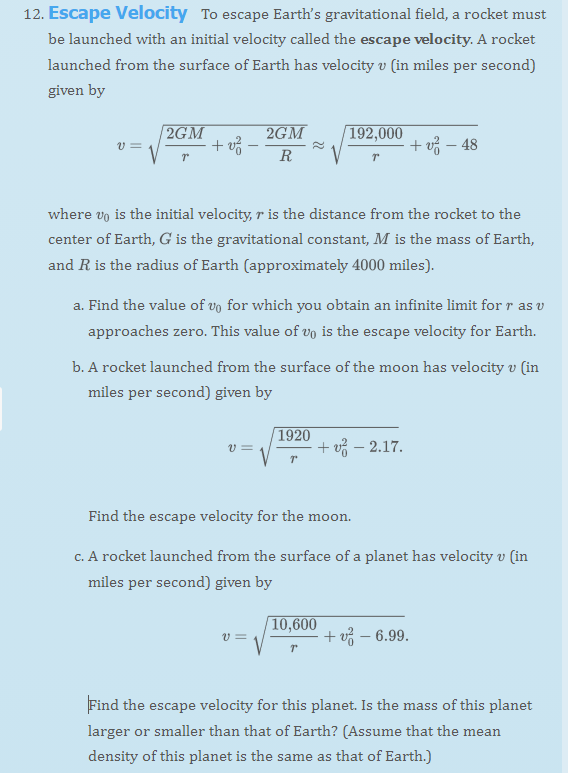12. Escape Velocity To escape Earth's gravitational field, a rocket must be launched with an initial velocity called the escape velocity. A rocket launched from the surface of Earth has velocity v (in miles per second) given by V = 2GM Tº + v² - 2GM R where vo is the initial velocity, r is the distance from the rocket to the center of Earth, G is the gravitational constant, M is the mass of Earth, and R is the radius of Earth (approximately 4000 miles). V= a. Find the value of vo for which you obtain an infinite limit for r as v approaches zero. This value of vo is the escape velocity for Earth. 192,000 T b. A rocket launched from the surface of the moon has velocity v (in miles per second) given by V = 1920 T +v-48 + - 2.17. Find the escape velocity for the moon. c. A rocket launched from the surface of a planet has velocity v (in miles per second) given by 10,600 T + v² - 6.99.
12. Escape Velocity To escape Earth's gravitational field, a rocket must be launched with an initial velocity called the escape velocity. A rocket launched from the surface of Earth has velocity v (in miles per second) given by V = 2GM Tº + v² - 2GM R where vo is the initial velocity, r is the distance from the rocket to the center of Earth, G is the gravitational constant, M is the mass of Earth, and R is the radius of Earth (approximately 4000 miles). V= a. Find the value of vo for which you obtain an infinite limit for r as v approaches zero. This value of vo is the escape velocity for Earth. 192,000 T b. A rocket launched from the surface of the moon has velocity v (in miles per second) given by V = 1920 T +v-48 + - 2.17. Find the escape velocity for the moon. c. A rocket launched from the surface of a planet has velocity v (in miles per second) given by 10,600 T + v² - 6.99.
College Physics
1st Edition
ISBN:9781938168000
Author:Paul Peter Urone, Roger Hinrichs
Publisher:Paul Peter Urone, Roger Hinrichs
Chapter6: Uniform Circular Motion And Gravitation
Section: Chapter Questions
Problem 48PE: Integrated Concepts Space debris left from old satellites and their launchers is becoming a hazard...
Related questions
Topic Video
Question
100%

Transcribed Image Text:12. Escape Velocity To escape Earth's gravitational field, a rocket must
be launched with an initial velocity called the escape velocity. A rocket
launched from the surface of Earth has velocity v (in miles per second)
given by
V =
2GM
Tº
+ v² -
2GM
R
where vo is the initial velocity, r is the distance from the rocket to the
center of Earth, G is the gravitational constant, M is the mass of Earth,
and R is the radius of Earth (approximately 4000 miles).
V=
a. Find the value of vo for which you obtain an infinite limit for r as v
approaches zero. This value of vo is the escape velocity for Earth.
192,000
T
b. A rocket launched from the surface of the moon has velocity v (in
miles per second) given by
V =
1920
T
+v-48
+ - 2.17.
Find the escape velocity for the moon.
c. A rocket launched from the surface of a planet has velocity v (in
miles per second) given by
10,600
T
+ v² - 6.99.
Find the escape velocity for this planet. Is the mass of this planet
larger or smaller than that of Earth? (Assume that the mean
density of this planet is the same as that of Earth.)
Expert Solution
This question has been solved!
Explore an expertly crafted, step-by-step solution for a thorough understanding of key concepts.
This is a popular solution!
Trending now
This is a popular solution!
Step by step
Solved in 2 steps with 2 images

Knowledge Booster
Learn more about
Need a deep-dive on the concept behind this application? Look no further. Learn more about this topic, physics and related others by exploring similar questions and additional content below.Recommended textbooks for you

College Physics
Physics
ISBN:
9781938168000
Author:
Paul Peter Urone, Roger Hinrichs
Publisher:
OpenStax College

Physics for Scientists and Engineers: Foundations…
Physics
ISBN:
9781133939146
Author:
Katz, Debora M.
Publisher:
Cengage Learning

Physics for Scientists and Engineers, Technology …
Physics
ISBN:
9781305116399
Author:
Raymond A. Serway, John W. Jewett
Publisher:
Cengage Learning

College Physics
Physics
ISBN:
9781938168000
Author:
Paul Peter Urone, Roger Hinrichs
Publisher:
OpenStax College

Physics for Scientists and Engineers: Foundations…
Physics
ISBN:
9781133939146
Author:
Katz, Debora M.
Publisher:
Cengage Learning

Physics for Scientists and Engineers, Technology …
Physics
ISBN:
9781305116399
Author:
Raymond A. Serway, John W. Jewett
Publisher:
Cengage Learning


Glencoe Physics: Principles and Problems, Student…
Physics
ISBN:
9780078807213
Author:
Paul W. Zitzewitz
Publisher:
Glencoe/McGraw-Hill

College Physics
Physics
ISBN:
9781285737027
Author:
Raymond A. Serway, Chris Vuille
Publisher:
Cengage Learning